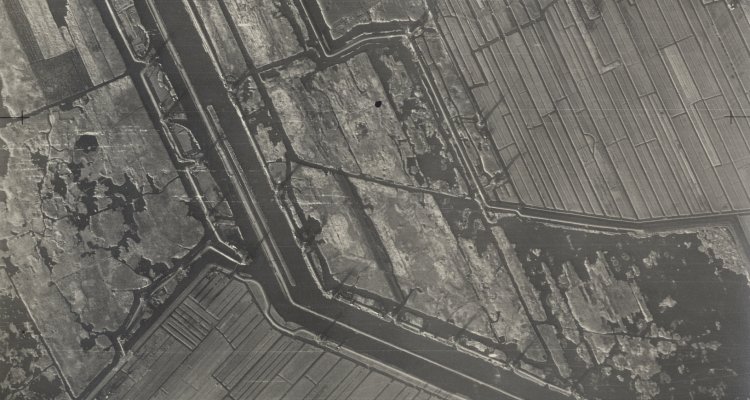
About the RAF aerial photographs, 1943 - 1947
Since 1994 Wageningen University & Research (WUR) Library houses a collection of aerial photographs taken by the Allied Air Forces, also known as the RAF-collection. The photos were mainly taken between September 1944 and May 1945 during the liberation of the Netherlands. The collection came from the Dutch Institute of Soil Mapping in Wageningen (StiBoKa, later Staring Centrum, Alterra, now Wageningen Environmental Research). This institute received the collection after World War II to use them as source of information for producing soil maps. Because of the relevance of the pictures for research on land use, the collection was donated in 1994 to WUR Library.
The collections contains 94,257 photos, taken with different cameras, on different heights and from different angles, mainly vertical but some were taken oblique.
Some of the photos are distorted due to hazardous conditions during the reconnaissance flights and the hasty photographic production and intensive use. The photos were taken by RAF pilots who flew in small airplanes like Spitfires and Mosquitos in sorties (flights) of several runs of tens of photos. Within a run the photos overlap 60% so that they can offer 3D images when studied with a stereoscopic viewer.
Source: Een blik op bezet Nederland : luchtfoto's van de geallieerden. Door G. Staal en R.P.G.A. Voskuil. Wageningen : Studium Generale Landbouwhogeschool, 1980.
What can you see?
Events in the Netherlands during World War II
During World War II the Netherlands were occupied by Nazi Germany. From the start to the finish these aerial photographs show traces of:
- Dutch and German defence lines like the Grebbelinie
- bombarded cities such as Rotterdam with vacant building plots in the centre
- bombarded landing strips, bridges, railways and harbours
- newly or rebuild places
- defence structures during the occupation by the Germans such as the Atlantik Wall, bunkers, tank ditches and trenches,
- macabre places such as concentration camps like Vught and Westerbork
- and finally traces from the Allied actions during the liberation in 1944-'45 such as inundations, crashed airplanes, Operation Market Garden and even more bombarded places
Needless to state that the original photographs themselves are worth of study as an unique war relict. The images are also frequently used to trace unexploded bombs and ammunition and other potential risk areas for new urban and infrastructural planning and development.
Changes of topographical features and land use in the 20th century
Detailed mapping in the Netherlands in the twentieth century was mainly done for the topographical map on a scale of 1:25,000. And the end of the nineteenth century a series in 776 sheets started in the so-called Bonne-projection. They were no longer renewed after1937. A new series - with a different projection - started much later, in the early fifties of the 20th century. These aerial photographs form a very detailed and unique source of topographical information for the period between 1937 and the late fifties. And a lot more can be seen from these photographs than from the generated generalized maps.
The photographs were taken at a crucial tipping point in urban, rural and infrastructural development of the Netherlands. Cities and villages grew already steadily but started to grow tremendously after World War II due to building in a larger scale because of demographical growth and wealth. Land consolidation and reclamation changed the scale of land plots and use. New uses such as nature reserves and recreation appeared. Infrastructural needs were expanding as well.
Archaeological and historic traces in the Dutch landscape over a long period of time
The deposits from different kind of soils from the beginning of the Dutch multi river delta can be studied from aerial photographs. Soil and geomorphological maps have been made with the use of these photographs. The differences in soil also causes different land uses and parcelling in early agriculture
Because of the high ground water level due to broken dikes and inundations (pre)historic features are also visible which are actually beneath the surface of meadows. Differences in vegetation and water saturation is showing in grayscale structures. Thus showing old land uses and settlements left from prehistoric times onwards such as Celtic fields (small agricultural plots), Hanseatic roads, fortified places and country estates.
Facts and figures
The collection comprises of 94,257 photographs made by the Allied Air Force or commonly referred to as Royal Air Force (RAF) flying over the Netherlands. The flight dates range from 14 April 1943 until 18 June 1947. Most photographs are taken from September 1944 until May 1945. The photographs are taken within a series or run in which the photographs are overlapping each other for 60% to allow 3D viewing.
Usually there are two runs of photographs taken together: 3000 series (port) and the 4000 series (starboard). Photograph number 3001 borders 4001 but there's no overlap between them. The scale of the photographs varies for each flight from 1 : 5,000 to 1 : 73,500, common is 1: 7,600 to 18,000. The collection consist of two kinds of photographs:
- normal sized, vertical taken photographs (size 17,8 x 21,8 cm): collection number 1-354, 357-358 and 454-458 ; scale 1:7.600 till 1:18.800 (ca. 91.000 photographs).
- small photographs, either oblique from low heights or vertical from great heights (size 12,5 x 12,8 cm): collection number 500-573; no scale relevant or scale approximately 1:57.000 (ca. 3.250 photographs).
- note that the numbers 355-356, 359-446 and 453 are missing in our collection. They might be at the Dutch Land Registry Office, the Kadaster at Zwolle.